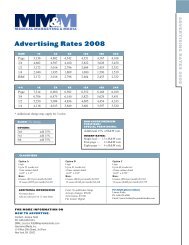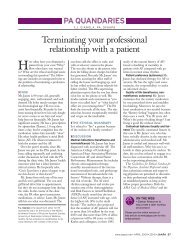Safeguarding the new currency of business - PwC
Safeguarding the new currency of business - PwC
Safeguarding the new currency of business - PwC
Create successful ePaper yourself
Turn your PDF publications into a flip-book with our unique Google optimized e-Paper software.
Advisory Services<br />
Security<br />
<strong>Safeguarding</strong> <strong>the</strong> <strong>new</strong><br />
<strong>currency</strong> <strong>of</strong> <strong>business</strong>*<br />
Findings from <strong>the</strong> 2008 Global State <strong>of</strong><br />
Information Security Study ®
Table <strong>of</strong> contents
The heart <strong>of</strong> <strong>the</strong> matter 1<br />
Information is <strong>the</strong> <strong>new</strong> <strong>currency</strong> <strong>of</strong> <strong>business</strong>—a<br />
critical corporate asset whose value rises and<br />
falls depending on when, how, where and by<br />
whom it is placed into circulation as a medium<br />
<strong>of</strong> exchange. Therein lie <strong>the</strong> risks. And <strong>the</strong><br />
opportunities.<br />
An in-depth discussion 3<br />
Companies across <strong>the</strong> world are confronting<br />
real, growing, and strategic risks to <strong>the</strong>ir<br />
information assets.<br />
I. As <strong>the</strong> drivers <strong>of</strong> security spending evolve, executive perceptions<br />
about what’s most important are not necessarily fully aligned. 4<br />
II. This year, respondents trumpet a headlong rush into technology.<br />
But <strong>the</strong>se investments don’t necessarily mean better security. 12<br />
III. From protecting privacy to preventing data loss: opportunities<br />
to improve safeguards abound.<br />
IV. Companies in some regions <strong>of</strong> <strong>the</strong> world—though not all—<br />
are expanding <strong>the</strong>ir security capabilities at a tremendous pace. 32<br />
What this means for your <strong>business</strong> 39<br />
Insist on a risk-based, integrated, and proactive<br />
approach to safeguarding information. Then<br />
execute it.<br />
Methodology 41<br />
October 2008<br />
20
The heart <strong>of</strong> <strong>the</strong> matter<br />
Information is <strong>the</strong> <strong>new</strong><br />
<strong>currency</strong> <strong>of</strong> <strong>business</strong>—a<br />
critical corporate asset<br />
whose value rises and<br />
falls at different times,<br />
and in different ways,<br />
depending on when,<br />
how, where and by<br />
whom it is placed into<br />
circulation as a medium<br />
<strong>of</strong> exchange.<br />
Therein lie <strong>the</strong> risks.<br />
And <strong>the</strong> opportunities.<br />
1
It’s a different world.<br />
Information has become <strong>the</strong> <strong>new</strong> <strong>currency</strong> <strong>of</strong> <strong>business</strong>—and its portability,<br />
accessibility and mobility back and forth across international, corporate<br />
and organizational boundaries are crucial components <strong>of</strong> a collaborative,<br />
globally connected <strong>business</strong> world.<br />
At <strong>the</strong> same time, however, protecting corporate information assets is<br />
equally critical—especially as mobile devices proliferate, open use <strong>of</strong> <strong>the</strong><br />
Internet surges, <strong>new</strong> <strong>business</strong> models shake out, and strategic sourcing<br />
initiatives stretch “long reach” supply chains fur<strong>the</strong>r and across more<br />
countries and companies than ever before.<br />
Just how well are companies across global markets, sectors and regions<br />
addressing <strong>the</strong>se challenges this year?<br />
We wanted to know. So we asked more than 7,000 CEOs, CFOs, CIOs,<br />
CSOs, vice presidents and directors <strong>of</strong> IT and information security from<br />
119 countries.<br />
One <strong>of</strong> <strong>the</strong> most striking survey results from <strong>the</strong> 2008 Global State<br />
<strong>of</strong> Information Security study is that—across industries and sectors,<br />
countries and regions, <strong>business</strong> models and company sizes—most<br />
respondents are reporting strong, <strong>of</strong>ten double-digit advances in<br />
implementing <strong>new</strong> security technologies, across virtually every security<br />
domain, from prevention to detection.<br />
Yet o<strong>the</strong>r results indicate that, in spite <strong>of</strong> <strong>the</strong> rapidly evolving maturity <strong>of</strong><br />
security capabilities for so many companies, more than three out <strong>of</strong> every<br />
ten survey respondents cannot answer basic questions about <strong>the</strong> risks to<br />
<strong>the</strong>ir company’s key information.<br />
Moreover, <strong>the</strong>se trends are playing out differently across regions <strong>of</strong> <strong>the</strong><br />
world. Asian companies—led principally by India—continue to overtake<br />
North American ones in establishing leading global practices in security.<br />
And South American security and privacy practices are advancing so<br />
quickly, <strong>the</strong>y are likely to surpass Europe’s within two years.<br />
What are <strong>the</strong> implications <strong>of</strong> <strong>the</strong>se trends on your <strong>business</strong> strategies?<br />
Where does your organization sit in this spectrum? What actions can you<br />
take to improve its position?<br />
Here’s a brief overview <strong>of</strong> <strong>the</strong> critical areas we believe deserve your<br />
attention—and why we believe that, from this point forward—quarter-byquarter,<br />
<strong>the</strong> companies that do <strong>the</strong> best job at safeguarding <strong>the</strong>ir <strong>business</strong><br />
<strong>currency</strong> and preventing data and identity <strong>the</strong>ft will be those that take a<br />
risk-based, integrated and proactive approach.<br />
The heart <strong>of</strong> <strong>the</strong> matter 2
An in-depth discussion<br />
Companies across <strong>the</strong><br />
world are confronting<br />
real, growing, and<br />
strategic risks to <strong>the</strong>ir<br />
information assets.<br />
3
I. As <strong>the</strong> drivers <strong>of</strong> security spending evolve—<br />
executive perceptions about what’s most<br />
important are not necessarily fully aligned<br />
Finding #1<br />
Change almost rivals compliance as a leading driver <strong>of</strong> spending.<br />
Finding #2<br />
Compliance is still a priority, <strong>of</strong> course. Yet few companies have a wellrounded<br />
view <strong>of</strong> <strong>the</strong>ir compliance activities.<br />
Finding #3<br />
Executive misalignment can undermine value from investments.<br />
An in-depth discussion 4
5<br />
Finding #1. Change almost rivals compliance as a<br />
leading driver <strong>of</strong> spending<br />
The shift is subtle. But it’s impossible to ignore.<br />
Over <strong>the</strong> last decade or more, one <strong>of</strong> <strong>the</strong> most consistent and enduring<br />
characteristics <strong>of</strong> executive decision-making on information security and<br />
privacy issues has been <strong>the</strong> emphasis on preventing harm. And this focus,<br />
<strong>of</strong> course, will continue. After all, isn’t security, by nature, principally about<br />
protection?<br />
Not anymore.<br />
Not, at least, according to <strong>the</strong> executives accountable for information<br />
security’s performance in a world where scrutiny over information<br />
security’s alignment with <strong>business</strong> objectives is becoming more and more<br />
rigorous.<br />
Asked to identify <strong>the</strong> most critical <strong>business</strong> issues or factors driving<br />
information security spending, survey respondents still point fi rst to<br />
“<strong>business</strong> continuity and disaster recovery” (57%). But <strong>the</strong>y also now cite<br />
“change” (40%) almost as <strong>of</strong>ten as <strong>the</strong>y do “compliance with regulations<br />
or internal policies” (44% and 46%). (Figure 1)
Figure 1: Percentage <strong>of</strong> respondents who identify <strong>the</strong> following <strong>business</strong> issues or factors as <strong>the</strong> most<br />
important drivers <strong>of</strong> information security spending in <strong>the</strong>ir organization 1<br />
Business continuity/disaster recovery 57%<br />
Internal policy compliance 46%<br />
Regulatory compliance 44%<br />
Change 40%<br />
1 Does not add up to 100%. Respondents were allowed to indicate multiple factors.<br />
Source: The Global State <strong>of</strong> Information Security Survey ® , 2008<br />
An in-depth discussion 6
7<br />
Finding #2. Compliance is still a priority, <strong>of</strong> course.<br />
Yet few companies have a well-rounded view <strong>of</strong><br />
<strong>the</strong>ir compliance activities.<br />
Regulations keep mounting. Just consider <strong>the</strong> epidemic <strong>of</strong> credit card<br />
fraud—and <strong>the</strong> widespread worldwide rush across many sectors with retail<br />
operations to comply with <strong>the</strong> <strong>new</strong> payment card industry data security<br />
standards (PCI DSS). Regulatory enforcement is rising too—particularly,<br />
for example, <strong>of</strong> payer violations <strong>of</strong> <strong>the</strong> U.S. Health Insurance Portability<br />
and Accountability Act (HIPAA).<br />
Are companies experiencing compliance fatigue? Or is a “culture <strong>of</strong><br />
compliance” taking root? It’s hard to tell. Maybe <strong>the</strong> fact that regulatory<br />
compliance is cited less <strong>of</strong>ten this year (44% vs. 54% in 2007) as a driver<br />
<strong>of</strong> security spending is ano<strong>the</strong>r sign that compliance is now more deeply<br />
embedded within organizations.<br />
O<strong>the</strong>r survey results, though, suggest that <strong>business</strong> and IT executives may<br />
not have a full picture <strong>of</strong> compliance lapses. Although confi dence that<br />
users are complying with internal security policies still runs optimistically<br />
high at 73%, most companies aren’t checking. Fewer than half <strong>of</strong> all<br />
respondents say <strong>the</strong>ir organization audits and monitors user compliance<br />
with security policies (43%). And only 44% conduct compliance testing.<br />
(Figure 2)
Figure 2: Percentage <strong>of</strong> respondents who report compliance-related capabilities<br />
Percentage <strong>of</strong> users that respondents estimate are complying with <strong>the</strong>ir company’s internal security policies 73%<br />
Conduct compliance testing 44%<br />
Audit or monitor user compliance with security policies 43%<br />
Source: The Global State <strong>of</strong> Information Security Survey ® , 2008<br />
An in-depth discussion 8
9<br />
Finding #3. Executive misalignment can<br />
undermine value from investments<br />
There are many places to spend limited security budget funds. Not all,<br />
however, are equally aligned with <strong>the</strong> <strong>business</strong>’s strategic direction. This<br />
year, Chief Information Security Offi cers (CISOs) are more likely than any<br />
o<strong>the</strong>r executives on <strong>the</strong> senior management team to perceive a signifi cant<br />
gap between security policy alignment with <strong>business</strong> objectives and<br />
security spending alignment with <strong>business</strong> objectives. In fact, CISOs<br />
believe that spending alignment trails policy alignment by a full 16 points—<br />
compared to CEOs, for example, who perceive no gap whatsoever.<br />
(Figure 3)<br />
This makes sense—at least, partly. Aren’t CISOs on <strong>the</strong> frontlines <strong>of</strong><br />
security, closer to how investments are being spent and, <strong>the</strong>refore, in <strong>the</strong><br />
best position to identify a spending alignment gap?<br />
Maybe so. But CISOs are also—or should be—among <strong>the</strong> executives<br />
best positioned to direct or infl uence security spending towards <strong>the</strong> most<br />
strategic, <strong>business</strong>-aligned priorities.<br />
There’s a more likely explanation <strong>of</strong> this perception gap—and a crucially<br />
important one: CISOs don’t see eye-to-eye with <strong>the</strong> rest <strong>of</strong> <strong>the</strong> executive<br />
suite on what single <strong>business</strong> issue is principally driving information<br />
security spending. They are far more likely to cite regulatory compliance<br />
than CEOs, CFOs, and even—quite surprisingly—Chief Compliance<br />
Offi cers (75% vs. 27%, 37% and 24%, respectively). And all <strong>of</strong> <strong>the</strong>se<br />
executives—in addition to <strong>the</strong> CIO, who is <strong>the</strong> only o<strong>the</strong>r <strong>business</strong> leader<br />
who sits on <strong>the</strong> IT side <strong>of</strong> <strong>the</strong> table—unanimously disagree: <strong>the</strong>y cite a<br />
completely different principal driver for security investments: <strong>business</strong><br />
continuity and disaster recovery. (Figure 4)<br />
Who’s right? It’s tempting to say: “That depends on <strong>the</strong> company”. After<br />
all, some CISOs are more aware than <strong>the</strong>ir executive counterparts <strong>of</strong><br />
security-related defi ciencies in regulatory compliance-related capabilities.<br />
And o<strong>the</strong>r CISOs are dangerously out-<strong>of</strong>-synch with <strong>the</strong> support that<br />
<strong>the</strong> most critical <strong>business</strong> objectives require <strong>of</strong> security—from both a<br />
“protection” and an “enablement” perspective.<br />
The real question shouldn’t be: “Who is right?” Instead, it should be:<br />
“Are we aligned, as a leadership team, on what we expect security to<br />
contribute to <strong>the</strong> <strong>business</strong>?” If <strong>the</strong> answer is “no”, follow up quickly with<br />
<strong>the</strong> game-changing question: “Why not?” And if your team isn’t sure, ask<br />
<strong>the</strong> CISOs. It looks like, instead <strong>of</strong> being part <strong>of</strong> <strong>the</strong> management process,<br />
<strong>the</strong>y are <strong>the</strong> whistle-blowers.
Figure 3: Percentage <strong>of</strong> senior <strong>business</strong> and IT executives who report that security policies and<br />
security spending are completely aligned with <strong>business</strong> objectives<br />
CEO CFO CIO CISO<br />
Security policies are completely aligned with <strong>business</strong> objectives 34% 28% 31% 38%<br />
Security spending is completely aligned with <strong>business</strong> objectives 34% 30% 21% 22%<br />
Alignment gap 0 -2 10 16<br />
Source: The Global State <strong>of</strong> Information Security Survey ® , 2008<br />
Figure 4: Differences among senior <strong>business</strong> and IT executives on what constitutes <strong>the</strong> primary<br />
<strong>business</strong> issue or factor driving information security spending 2<br />
CEO CFO CIO CISO<br />
Business continuity / Disaster recovery √ √ √<br />
Regulatory compliance √<br />
2 Respondents were asked to select from <strong>the</strong> following list: change, <strong>business</strong> continuity/disaster recovery, outsourcing, digital convergence trends,<br />
company reputation, terrorism, M&A activity, regulatory compliance, and internal policy compliance.<br />
Source: The Global State <strong>of</strong> Information Security Survey ® , 2008<br />
An in-depth discussion 10
II. This year, respondents trumpet a headlong<br />
rush into technology. But <strong>the</strong>se investments<br />
don’t necessarily mean better security.<br />
Finding #4<br />
It’s dramatically clear: one <strong>of</strong> <strong>the</strong> highest priorities for companies over<br />
<strong>the</strong> past year has been technology.<br />
Finding #5<br />
Many companies, however—if not most—do not know exactly where<br />
important data is located.<br />
Finding #6<br />
Companies need to focus more acutely on advancing critical<br />
processes—and supporting <strong>the</strong> people that run <strong>the</strong>m.<br />
An in-depth discussion 12
13<br />
Finding #4. It’s dramatically clear: one <strong>of</strong> <strong>the</strong><br />
highest priorities for companies over <strong>the</strong> past year<br />
has been technology.<br />
A big strategic step forward took place last year—when respondents<br />
reported, 17-to-20 point gains in appointing a senior information security<br />
executive and establishing an overall information security strategy.<br />
With <strong>new</strong> leadership and a plan in place—exactly where was <strong>the</strong><br />
investment emphasis was placed in 2008?<br />
The answer is in technology.<br />
Across industries, regions and <strong>business</strong> models, survey respondents<br />
report huge, double-digit gains in implementing <strong>new</strong> security-related<br />
technologies. In ten-point leaps, companies are much more likely, for<br />
example, to encrypt sensitive information not just in laptops but also in<br />
databases, fi le shares, backup tapes and removable media. They have<br />
also taken signifi cant strides in advancing Web/Internet capabilities—such<br />
as content fi lters, website certifi cation/accreditation, secure browsers,<br />
and web services security. And <strong>the</strong>y have made similar leaps ahead in<br />
technologies that help protect wireless devices and secure remote access<br />
via VPN as well as tools to prevent intrusions or discover unauthorized<br />
devices. (Figure 5)<br />
Here’s <strong>the</strong> hitch: capturing <strong>the</strong> <strong>business</strong> benefi ts <strong>of</strong> technologies intended<br />
to advance objectives related to security, privacy, compliance and<br />
<strong>business</strong> continuity also requires knowing as much as possible about<br />
where <strong>the</strong> greatest risks to sensitive information are coming from. And<br />
that, as we discuss next, appears to be a critical challenge.
Figure 5: Respondents report strong, double-digit advances in implementing technologies across most<br />
critical security and privacy domains<br />
2008 2007<br />
Encryption, Laptops 50% 40%<br />
Encryption, Databases 55% 45%<br />
Encryption, File shares 48% 37%<br />
Encryption, Backup tapes 47% 37%<br />
Encryption, Removable media 40% 28%<br />
Web/Internet, Content fi lters 69% 51%<br />
Web/Internet, Website certifi cation/accreditation 58% 48%<br />
Web/Internet, Secure browsers 66% 55%<br />
Web/Internet, Web services security 58% 48%<br />
Detection, Tools to discover unauthorized devices 51% 40%<br />
Prevention, Tools to prevent intrusions 62% 52%<br />
Prevention, Secure remote access via VPN 68% 59%<br />
Prevention, Wireless handheld device security technologies 42% 33%<br />
Source: The Global State <strong>of</strong> Information Security Survey ® , 2008<br />
An in-depth discussion 14
15<br />
Finding #5. Many companies, however—if not<br />
most—do not know exactly where important data<br />
is located.<br />
Progress always advances unevenly. Sector responses this year reveal<br />
that, in spite <strong>of</strong> <strong>the</strong> support provided by a much broader and stronger<br />
portfolio <strong>of</strong> technologies, a surprisingly large percentage <strong>of</strong> survey<br />
respondents “don’t know what <strong>the</strong>y don’t know”. In fact, more than three<br />
out <strong>of</strong> every ten respondents cannot answer basic questions about <strong>the</strong><br />
risks to <strong>the</strong>ir company’s most sensitive information.<br />
How many security incidents occurred this year? Thirty-fi ve percent (35%)<br />
<strong>of</strong> respondents aren’t sure. What types <strong>of</strong> security incidents presented <strong>the</strong><br />
greatest threats to <strong>the</strong> company’s most sensitive information, assets and<br />
operations? Forty-four percent (44%) <strong>of</strong> respondents couldn’t say. What<br />
about <strong>the</strong> source <strong>of</strong> incidents—whe<strong>the</strong>r <strong>the</strong> attack was most likely to have<br />
originated from employees (ei<strong>the</strong>r current or former), customers, partners<br />
or suppliers, hackers or o<strong>the</strong>rs? Forty-two percent (42%) don’t know.<br />
(Figure 6)<br />
Internal stakeholders looking to defend <strong>the</strong>se numbers won’t fi nd it hard.<br />
Any large survey—<strong>of</strong> ei<strong>the</strong>r thousands <strong>of</strong> companies or one—will fi nd<br />
many respondents who don’t have a front-row view <strong>of</strong> <strong>the</strong> attack or o<strong>the</strong>r<br />
form <strong>of</strong> fi rst-hand knowledge.<br />
That’s true. But it also misses <strong>the</strong> point. What matters, <strong>of</strong> course, is<br />
improving an organization’s ability to defend and prevent attacks on an<br />
ongoing basis—without distracting people from <strong>the</strong> every-day operational<br />
needs <strong>of</strong> <strong>the</strong> <strong>business</strong> or incurring <strong>the</strong> exorbitantly high price tags<br />
associated with a reactive response to an unexpected (but foreseeable)<br />
crisis.<br />
And that requires getting key information about <strong>the</strong> risks to an<br />
organization’s data and systems very quickly from <strong>the</strong> front row to<br />
everyone else in <strong>the</strong> house. Expanding security awareness at every level <strong>of</strong><br />
<strong>the</strong> enterprise is essential.
Figure 6: Percentage <strong>of</strong> respondents who don’t know basic information about <strong>the</strong> risks to <strong>the</strong>ir<br />
company’s information assets<br />
65% Number <strong>of</strong> security events in past 12 months<br />
56% Types <strong>of</strong> security events that occurred<br />
58% Likely source <strong>of</strong> security incident<br />
Source: The Global State <strong>of</strong> Information Security Survey ® , 2008<br />
35%<br />
44%<br />
42%<br />
An in-depth discussion 16
17<br />
Finding #6. Companies need to focus more<br />
acutely on advancing critical processes—and<br />
supporting <strong>the</strong> people that run <strong>the</strong>m.<br />
One <strong>of</strong> <strong>the</strong> best ways <strong>of</strong> improving enterprise-wide visibility into <strong>the</strong> crucial<br />
details <strong>of</strong> actual security incidents is to match technology investments<br />
with an equally robust commitment to <strong>the</strong> o<strong>the</strong>r principal drivers <strong>of</strong><br />
security’s value: <strong>the</strong> critical <strong>business</strong> and security processes that support<br />
technology, and <strong>the</strong> people that administer <strong>the</strong>m.<br />
This year, respondents report noteworthy advances in implementing a few<br />
critical processes—such as establishing security standards for handheld/<br />
portable devices like fl ash drives or external drives (42% vs. 32% in 2007)<br />
and cellular/PCS/wireless systems (40% vs. 29%). Yet gains tend to be<br />
more muted (i.e., in <strong>the</strong> single digits) for most o<strong>the</strong>r important security<br />
processes—such as establishing a centralized security information<br />
management process (51% vs. 44%), implementing a <strong>business</strong> continuity/<br />
disaster recovery plan (55% vs. 51%) and using tiered au<strong>the</strong>ntication<br />
levels based on user risk classifi cation (36% vs. 29%).<br />
Addressing <strong>the</strong> people side <strong>of</strong> effective security also remains a challenge.<br />
For example, only about half <strong>of</strong> all companies conduct personnel<br />
background checks (51%) or have people dedicated to monitoring<br />
employee use <strong>of</strong> Internet/information assets (50%). (Figure 7)
Figure 7: Percentage <strong>of</strong> respondents reporting gains in key processes and people-related capabilities<br />
Implemented security standards for handheld/portable devices (like fl ash drives)<br />
2008 42%<br />
2007 32%<br />
Established security standards for cellular/PCS/wireless systems<br />
2008 40%<br />
2007 29%<br />
Use a centralized security information management process<br />
2008 51%<br />
2007 44%<br />
Have a <strong>business</strong> continuity/disaster recovery plan<br />
2008 55%<br />
2007 51%<br />
Use tiered au<strong>the</strong>ntication levels based on user risk classifi cation<br />
2008 36%<br />
2007 29%<br />
Conduct personnel background checks<br />
2008 51%<br />
2007 52%<br />
Have people dedicated to monitoring employee use <strong>of</strong> Internet/information asset<br />
2008 50%<br />
2007 48%<br />
Source: The Global State <strong>of</strong> Information Security Survey ® , 2008<br />
An in-depth discussion 18
III. From protecting privacy to preventing data<br />
loss: opportunities to improve safeguards<br />
abound.<br />
Finding #7<br />
Privacy: Few companies are well prepared to protect it.<br />
Finding #8<br />
Access control: Progress is clear, but more work lies ahead.<br />
Finding #9<br />
Sourcing, alliances and o<strong>the</strong>r collaborative networks: Risks linger.<br />
Finding #10<br />
Data loss prevention: A critical tool—if implemented correctly.<br />
An in-depth discussion 20
21<br />
Finding #7. Privacy: Few companies are well<br />
prepared to protect it.<br />
Gains in privacy protections have slowed—in spite <strong>of</strong> a slew <strong>of</strong> highpr<strong>of</strong>i<br />
le headlines this year announcing breaches <strong>of</strong> consumer information,<br />
information subject to protection under regulations such as <strong>the</strong> U.S. Health<br />
Insurance Portability and Accountability Act (HIPAA) and <strong>the</strong> E.U.’s Data<br />
Protection Directive.<br />
Companies worldwide are somewhat more likely this year to review <strong>the</strong>ir<br />
privacy policies at least once a year (47% vs. 44%) and require employees<br />
to certify in writing that <strong>the</strong>y are complying with <strong>the</strong>m (58% vs. 53%).<br />
But while proactive measures such as <strong>the</strong>se are important, so is knowing<br />
exactly where this information resides within <strong>the</strong> organization and who has<br />
been granted access to it. Yet 71% <strong>of</strong> respondents say <strong>the</strong>ir organization<br />
does not have an accurate inventory <strong>of</strong> where personal data for employees<br />
and customers is stored.<br />
O<strong>the</strong>r privacy-related opportunities also beckon. Many companies could<br />
benefi t by joining <strong>the</strong> ranks <strong>of</strong> organizations that audit privacy standards<br />
through third-party assessments (25%) and conduct privacy assessments<br />
internally through governance mechanisms such as internal audit reviews<br />
(43%). (Figure 8)
Figure 8: Percentage <strong>of</strong> organizations with privacy-related capabilities<br />
Require employees to certify in writing that <strong>the</strong>y are complying with privacy policies 58%<br />
Review privacy policies at least once a year 47%<br />
Conduct privacy assessments internally (e.g., through internal audit) 43%<br />
Have accurate inventory where personal customer/employee data is stored 29%<br />
Audit privacy standards through third-party assessments 25%<br />
Have inventory <strong>of</strong> all third parties handling sensitive data 22%<br />
Source: The Global State <strong>of</strong> Information Security Survey ® , 2008<br />
An in-depth discussion 22
23<br />
Finding #8. Access control: Progress is clear, but<br />
more work lies ahead.<br />
Among <strong>the</strong> greatest risks to sensitive corporate information is that a user<br />
with ei<strong>the</strong>r legitimate or unauthorized access to systems will compromise<br />
data—intentionally or accidentally.<br />
This year, survey respondents were much less likely to view <strong>the</strong>ir own staff<br />
as <strong>the</strong> likely source <strong>of</strong> a security incident (34% vs. 48% in 2007).<br />
And small wonder—given that more now report using tools such as a<br />
centralized user data store (55% vs. 47%) and reduced/single sign-on<br />
s<strong>of</strong>tware (35% vs. 28%).<br />
Yet o<strong>the</strong>r responses reveal that, while <strong>the</strong> dangers are tangible, <strong>the</strong>y can<br />
also be mitigated. Asked about what primary methods were used to<br />
exploit corporate systems, almost half—46%—cited <strong>the</strong> abuse <strong>of</strong> valid<br />
user accounts and permissions.<br />
Survey results also indicated that a strategic approach to access-related<br />
risks benefi ts only a minority <strong>of</strong> companies worldwide. Only 41% have an<br />
identity management strategy in place.<br />
More than half could better mitigate <strong>the</strong> risks <strong>of</strong> data and identity <strong>the</strong>ft<br />
by implementing user activity monitoring tools (52%) and deploying<br />
automated account de-provisioning (73%). (Figures 9 and 10)
Figure 9: Estimated likely source <strong>of</strong> security incidents over <strong>the</strong> last 12 months 3<br />
Employee<br />
2008 34%<br />
2007 48%<br />
Former employee<br />
2008 16%<br />
2007 21%<br />
Hacker<br />
2008 28%<br />
2007 41%<br />
3 O<strong>the</strong>r likely sources <strong>of</strong> security incidents cited in 2008 included customers (8%), service providers/contractors (8%), partners/suppliers (7%),<br />
terrorists (2%) and foreign governments (2%). Forty two percent (42%) <strong>of</strong> respondents didn’t know. Data does not add up to 100%. Respondents<br />
were allowed to indicate multiple factors.<br />
Source: The Global State <strong>of</strong> Information Security Survey ® , 2008<br />
An in-depth discussion 24
Figure 10: Percentage <strong>of</strong> organizations with access control-related security and privacy protection<br />
capabilities<br />
Centralized user data store<br />
2008 55%<br />
2007 47%<br />
User activity monitoring tools<br />
2008 48%<br />
2007 42%<br />
Identity management strategy<br />
2008 41%<br />
2007 36%<br />
Reduced/single sign-on s<strong>of</strong>tware<br />
2008 35%<br />
2007 28%<br />
Automated account de-provisioning<br />
2008 27%<br />
2007 22%<br />
Source: The Global State <strong>of</strong> Information Security Survey ® , 2008<br />
25
An in-depth discussion 26
27<br />
Finding #9. Sourcing, alliances and o<strong>the</strong>r<br />
collaborative networks: Risks linger<br />
As companies seek sourcing benefi ts, faster innovation, lower-cost<br />
manufacturing, and entry into emerging markets, partnering arrangements<br />
such as strategic alliances and joint ventures are on <strong>the</strong> rise.<br />
Yet fewer than half <strong>of</strong> all survey respondents say <strong>the</strong>ir organization has<br />
established security baselines for external partners, customers, suppliers<br />
and vendors (43%) or requires third parties to comply with internal privacy<br />
policies (37%). And less than 3 out <strong>of</strong> 10 have an inventory <strong>of</strong> third parties<br />
handling <strong>the</strong> personal data <strong>of</strong> customers and suppliers (22%) or conduct<br />
due diligence <strong>of</strong> <strong>the</strong>se third parties (28%). (Figure 11)<br />
Are executives aware <strong>of</strong> <strong>the</strong> risks to <strong>the</strong>ir information as it passes back<br />
and forth between parties? They are. Asked how confi dent <strong>the</strong>y were in<br />
<strong>the</strong>ir partners’ or suppliers’ information security practices, 78% <strong>of</strong> <strong>the</strong><br />
respondents—an overwhelming majority—said <strong>the</strong>y were only “somewhat”<br />
confi dent (53%), “not at all” confi dent (10%), or “didn’t know” (15%).<br />
(Figure 12)
Figure 11: Percentage <strong>of</strong> organizations with security capabilities that safeguard sensitive information<br />
shared with third-party organizations<br />
Have established security baselines for partners, customers, suppliers and vendors 43%<br />
Require third parties (including outsourced vendors) to comply with privacy policies 37%<br />
Conduct due diligence <strong>of</strong> third parties handling personal data <strong>of</strong> employees/customers 28%<br />
Have inventory <strong>of</strong> all third parties handling sensitive data 22%<br />
Figure 12: Few respondents are very confi dent in <strong>the</strong>ir partners’ or suppliers’ information security<br />
practices<br />
Not all confi dent: 10% Somewhat confi dent: 53% Very confi dent: 22% Don’t know: 15%<br />
Source: The Global State <strong>of</strong> Information Security Survey ® , 2008<br />
An in-depth discussion 28
29<br />
Finding #10. Data loss prevention: A critical tool—<br />
if implemented correctly<br />
When data breaches occur, <strong>the</strong>y hurt. This year, a signifi cant percentage <strong>of</strong><br />
respondents who cite negative <strong>business</strong> impacts from security breaches<br />
point to fi nancial losses (39%), <strong>the</strong>ft <strong>of</strong> intellectual property (30%),<br />
compromise to brands or corporate reputation (27%), and fraud (21%),<br />
among o<strong>the</strong>r damages. (Figure 13)<br />
In addition to citing advances in encrypting data at rest, in motion and at<br />
end-points, 3 out <strong>of</strong> 10 respondents (29%) say <strong>the</strong>ir organization now has<br />
a data loss prevention (DLP) capability in place. And ano<strong>the</strong>r 10% say that<br />
implementing DLP is a “hot priority” over <strong>the</strong> next 12 months. (Figure 14)<br />
But point solutions aren’t enough.<br />
For capabilities like DLP to be effective, companies must decide on <strong>the</strong><br />
right strategy, engage <strong>the</strong> right people, target <strong>the</strong> right data, and employ<br />
<strong>the</strong> right technology.<br />
By aligning a well-designed data loss prevention program with an overall<br />
data protection strategy, companies can gain control over sensitive data,<br />
reduce <strong>the</strong> cost <strong>of</strong> data breaches and achieve greater visibility into how<br />
data is used throughout <strong>the</strong> organization. 4<br />
4 For additional information on data loss prevention, see PricewaterhouseCoopers’s Data Loss<br />
Prevention: Keeping sensitive data out <strong>of</strong> <strong>the</strong> wrong hands
Figure 13: Percentage <strong>of</strong> respondents reporting <strong>the</strong> following <strong>business</strong> impacts <strong>of</strong> a security breach<br />
Financial losses 39%<br />
Theft <strong>of</strong> intellectual property 30%<br />
Compromise to brands or corporate reputation 27%<br />
Fraud 21%<br />
Source: The Global State <strong>of</strong> Information Security Survey ® , 2008<br />
Figure 14: Percentage <strong>of</strong> respondents citing current and intended use <strong>of</strong> data loss prevention<br />
technologies<br />
Have capability now 29%<br />
Plan to implement within<br />
12 months 10%<br />
Source: The Global State <strong>of</strong> Information Security Survey ® , 2008<br />
An in-depth discussion 30
IV. Companies in some regions <strong>of</strong> <strong>the</strong> world—<br />
though not all—are expanding <strong>the</strong>ir security<br />
capabilities at a tremendous pace.<br />
Finding #11<br />
India now leads o<strong>the</strong>r countries—while China posts big gains.<br />
Finding #12<br />
Asia’s security practices now on a par with those in North America.<br />
Finding #13<br />
Europe stalls—just as South America moves into <strong>the</strong> passing lane.<br />
An in-depth discussion 32
33<br />
Finding #11. India now leads o<strong>the</strong>r countries—<br />
while China posts big gains<br />
Perhaps <strong>the</strong> most dramatic and compelling highlights <strong>of</strong> this year’s<br />
survey are <strong>the</strong> breadth and depth <strong>of</strong> India’s advances across almost every<br />
security domain. Last year, 65% <strong>of</strong> Indian respondents reported that <strong>the</strong>ir<br />
organization planned to increase security spending in 2008—compared to<br />
44%, <strong>the</strong> global average—and clearly <strong>the</strong>y have.<br />
This year, Indian respondents say <strong>the</strong>ir organizations are much more likely<br />
to conduct employee security awareness training (68% vs. 51%), use<br />
malicious code detection tools (85% vs. 57%) and have security standards<br />
in place for handheld/portable devices (56% vs. 36%). In fact, over <strong>the</strong><br />
24 months since <strong>the</strong> survey was taken in 2006—and across most <strong>of</strong> <strong>the</strong><br />
metrics it tracks—Indian companies have advanced many <strong>of</strong> <strong>the</strong>ir security<br />
capabilities by more than 100%.<br />
As a result <strong>of</strong> this investment blitz, India’s security capabilities now<br />
surpass those in almost every country in <strong>the</strong> world. Indian respondents<br />
are more likely than those in <strong>the</strong> U.S., <strong>the</strong> U.K, and Australia, for example,<br />
to report that <strong>the</strong>ir company has a information security strategy in place<br />
(72% vs. 65%, 61%, and 51%, respectively), employs ei<strong>the</strong>r a CSO or<br />
a CISO (77% vs. 52%, 48% and 28%), and conducts an enterprise risk<br />
assessment at least yearly (78% vs. 60%, 58%, and 57%).<br />
And we expect India’s lead to widen by 2009. A clear majority <strong>of</strong> Indian<br />
respondents (72%) say security spending will increase over <strong>the</strong> next<br />
12 months—a signifi cantly higher level <strong>of</strong> commitment than reported,<br />
for example, by respondents in <strong>the</strong> US (39%) or indicated by <strong>the</strong> global<br />
average (44%).<br />
China also continues to make advances in security—though not as<br />
briskly or as strategically as India. The majority <strong>of</strong> Chinese respondents<br />
report now having an overall security strategy in place (54% vs. 41% in<br />
2007) as well as making strides in implementing technologies—such as<br />
content fi lters (62% vs. 35%), secure browsers (59% vs. 48%), and laptop<br />
encryption (53% vs. 42%). Chinese gains in people- and process-related<br />
areas, however, remain modest. (Figures 14, 15 and 16)
Figure 14: Indian respondents report signifi cant advances in security capabilities over <strong>the</strong> past three<br />
years<br />
2008 2007 2006 Three Yr.<br />
Gain<br />
Have an overall information security strategy 72% 62% 34% 112%<br />
Deploy malicious code detection tools 85% 57% 27% 215%<br />
Integrate privacy and compliance plans 44% 31% 23% 91%<br />
Engage periodic threat and vulnerability assessments 60% 40% 33% 82%<br />
Use tiered au<strong>the</strong>ntication based on user risk classifi cations 47% 31% 21% 124%<br />
Has security standards for handheld/portable devices 56% 36% 25% 124%<br />
Ensure <strong>the</strong> secure disposal <strong>of</strong> technology hardware 69% 51% 26% 165%<br />
Will increase security spending over next 12 months 72% 65% 69% —<br />
Source: The Global State <strong>of</strong> Information Security Survey ® , 2008<br />
Figure 15: Chinese respondents also report progress—particularly in security-related technologies 5<br />
2008 2007<br />
Have an overall information security strategy 54% 41%<br />
Deploy content fi lters 62% 35%<br />
Use secure browsers 59% 48%<br />
Encrypt laptops 53% 42%<br />
Leverage user activity monitoring tools 31% 25%<br />
Conduct personnel background checks 41% 37%<br />
Have security standards for handheld/portable devices 36% 33%<br />
Have established security baselines for suppliers and vendors 31% 30%<br />
5 2006 survey data for China is not available.<br />
Source: The Global State <strong>of</strong> Information Security Survey ® , 2008<br />
An in-depth discussion 34
Figure 16: India’s information security capabilities typically exceed those in o<strong>the</strong>r countries<br />
India U.S. U.K. Germany Brazil Australia China<br />
Have an overall information security strategy 72% 65% 61% 52% 46% 51% 54%<br />
Conduct enterprise risk assessment at least once a year 78% 60% 58% 58% 63% 57% 74%<br />
Use security in marketing as a competitive advantage 58% 37% 40% 45% 59% 35% 68%<br />
Employ a CISO or CSO 77% 52% 54% 36% 54% 28% 68%<br />
Will increase security spending over next 12 months 72% 39% 38% 35% 54% 36% 61%<br />
Have a <strong>business</strong> continuity and/or disaster recovery plan 63% 62% 60% 43% 43% 50% 33%<br />
Use centralized security information management process 63% 53% 50% 46% 53% 39% 44%<br />
Conduct active monitoring/analysis <strong>of</strong> security intelligence 69% 56% 55% 55% 54% 45% 41%<br />
Continuously prioritize data assets according to risk level 27% 26% 28% 25% 25% 20% 28%<br />
Have an employee security awareness program 68% 61% 51% 44% 45% 54% 52%<br />
Have intrusion prevention tools 69% 63% 59% 65% 64% 55% 57%<br />
Have intrusion detection tools 68% 65% 62% 60% 67% 57% 46%<br />
Have accurate inventory <strong>of</strong> where sensitive data stored 40% 41% 42% 38% 28% 28% 38%<br />
Have implemented a data loss prevention capability 34% 30% 27% 56% 30% 18% 36%<br />
Don’t know what types <strong>of</strong> security incidents occurred 28% 49% 52% 52% 39% 46% 16%<br />
Source: The Global State <strong>of</strong> Information Security Survey ® , 2008<br />
35
Finding #12. Asia’s security practices now on a<br />
par with those in North America<br />
Asian companies no longer trail North American organizations in<br />
establishing leading practices in information security. Boosted by <strong>the</strong><br />
widespread advances made principally by India and, to a lesser extent,<br />
China, Singapore and Hong Kong, Asian security capabilities are now on a<br />
par with those in North America—and in some cases exceed <strong>the</strong>m.<br />
While Asian respondents are just as likely as North American ones to say<br />
<strong>the</strong>ir organization has an information security strategy (64%), <strong>the</strong>y are<br />
more likely to employ ei<strong>the</strong>r a CISO or CSO (63% vs. 52%) and rely upon<br />
a centralized security information management process (55% vs. 53%),<br />
among o<strong>the</strong>r security benchmarks.<br />
In protecting privacy, however, Asian companies lag behind those in<br />
North America. They’re less likely, for example, to employ a Chief Privacy<br />
Offi cer (18% vs. 21%), require employees to complete training in privacy<br />
practices (41% vs. 54%), and conduct due diligence <strong>of</strong> third parties<br />
handling sensitive data (30% vs. 33%).<br />
Survey results, however, strongly suggest that information security will<br />
remain a high priority for Asian organizations—at least over <strong>the</strong> near-term:<br />
almost 6 out <strong>of</strong> 10 Asian respondents expect <strong>the</strong>ir company will increase<br />
security spending over <strong>the</strong> next 12 months. (Figure 17)<br />
An in-depth discussion 36
37<br />
Finding #13. Europe stalls—just as South America<br />
moves into <strong>the</strong> passing lane<br />
Last year, Europe vied with North America in setting most <strong>of</strong> <strong>the</strong> highwater<br />
marks in security and privacy practices. This year, its relative<br />
position has slipped—nudged back less by North America’s moderate<br />
capability gains in 2008 than by an apparent stall in Europe’s progress.<br />
European companies, for example, are barely more likely this year than<br />
<strong>the</strong>y were in 2007 to conduct compliance testing (37% vs. 34%) and<br />
ensure <strong>the</strong> secure disposal <strong>of</strong> technology hardware (61% vs. 59%).<br />
Some <strong>of</strong> <strong>the</strong>se fi ndings are partly due to lower survey participation this<br />
year by countries such as France and <strong>the</strong> United Kingdom and greater<br />
participation by countries such as Finland and Spain—whose companies’<br />
security capabilities, in general, are not as developed.<br />
But in spite <strong>of</strong> <strong>the</strong>se disparities in year-to-year trending comparisons, it’s<br />
clear that while Europe now trails Asia and North America in many areas,<br />
South America is making great strides across many security domains—<br />
and catching up quickly.<br />
For example, <strong>the</strong> percentage <strong>of</strong> South American respondents who say<br />
<strong>the</strong>ir company has an identity management strategy leapt 13 points<br />
from 25% in 2007 to match Europe’s 38% this year—during which time<br />
European respondents reported only a two-point gain. (Figure 17)
Figure 17: O<strong>the</strong>r responses reveal signifi cant differences in security and privacy capabilities by region<br />
Asia North South Europe<br />
America America<br />
Have an overall information security strategy 64% 64% 43% 54%<br />
Conduct enterprise risk assessment at least once a year 71% 59% 64% 57%<br />
Will increase security spending over next 12 months 57% 39% 52% 36%<br />
Employ a CISO or CSO 63% 52% 56% 58%<br />
Engage both <strong>business</strong> and IT executives in addressing security 55% 62% 33% 44%<br />
Have established security baselines for third parties 46% 45% 41% 39%<br />
Have an identity management strategy 44% 43% 38% 38%<br />
Conduct compliance testing 51% 48% 40% 37%<br />
Security policies address data protection, disclosure and destruction 57% 56% 40% 44%<br />
Have a centralized information security management capability 55% 53% 49% 46%<br />
Encrypt databases 60% 56% 60% 47%<br />
Use vulnerability scanning tools 58% 59% 51% 47%<br />
Employ a CPO 18% 21% 21% 25%<br />
Require employees to complete training in privacy practices 41% 54% 30% 28%<br />
Conduct due diligence <strong>of</strong> third parties handling sensitive data 30% 33% 20% 22%<br />
Source: The Global State <strong>of</strong> Information Security Survey ® , 2008<br />
An in-depth discussion 38
What this means for your <strong>business</strong><br />
Insist on a riskbased,<br />
integrated, and<br />
proactive approach<br />
to safeguarding<br />
information.<br />
Then execute it.<br />
39
A risk-based, integrated approach is <strong>the</strong> best way to create a more secure<br />
and effi cient (as well as compliant) organization. And for many companies,<br />
adopting one represents a clear opportunity. Survey data supports this:<br />
Thirty-six percent (36%) <strong>of</strong> respondents say <strong>the</strong>ir organization<br />
integrates security and privacy compliance plans;<br />
Twenty-four (24%) ensure that <strong>the</strong>ir security policies address<br />
classifying <strong>the</strong> <strong>business</strong> value <strong>of</strong> data;<br />
And while 24% report that <strong>the</strong>ir organization continuously—not just<br />
periodically—prioritizes data and information assets according to <strong>the</strong>ir<br />
risk level, 30% report that <strong>the</strong>y don’t classify data and information<br />
assets at all.<br />
When undertaken correctly, a risk-based, integrated approach can help<br />
you (1) better understand <strong>the</strong> risks to your information across functions,<br />
assets, technologies and networks as well as <strong>the</strong> impacts to your <strong>business</strong><br />
when breaches occur; (2) know which information assets are most<br />
important and where <strong>the</strong>y are located; (3) allocate resources to <strong>the</strong> areas<br />
<strong>of</strong> opportunity and vulnerability that will deliver <strong>the</strong> greatest strategic<br />
<strong>business</strong> return to <strong>the</strong> organization, and (4) accelerate <strong>the</strong> transition <strong>of</strong><br />
your organization’s security, privacy and compliance functions from a<br />
reactive, “fi re-fi ghting” posture to a proactive, enablement-savvy one.<br />
What this means for your <strong>business</strong> 40
41<br />
Methodology<br />
The Global State <strong>of</strong> Information Security 2008 is a worldwide security<br />
survey by PricewaterhouseCoopers, CIO Magazine and CSO Magazine.<br />
It was conducted online from March 25 to June 26, 2008. Readers <strong>of</strong> CIO<br />
and CSO Magazines and clients <strong>of</strong> PricewaterhouseCoopers from around<br />
<strong>the</strong> globe were invited via email to take <strong>the</strong> survey. The results discussed<br />
in this report are based on <strong>the</strong> responses <strong>of</strong> more than 7,000 CEOs, CFOs,<br />
CIOs, CSOs, vice presidents and directors <strong>of</strong> IT and information security<br />
from 119 countries. Thirty-nine percent (39%) <strong>of</strong> respondents were from<br />
North America, 27% from Europe, 17% from Asia, 15% from South<br />
America, and 2% from <strong>the</strong> Middle East and South Africa. The margin <strong>of</strong><br />
error is ±1%.
pwc.com/giss2008<br />
For more information, please<br />
contact:<br />
Gary Loveland<br />
Principal, National Security Leader<br />
949.437.5380<br />
gary.loveland@us.pwc.com<br />
Mark Lobel<br />
Principal<br />
646.471.5731<br />
mark.a.lobel@us.pwc.com<br />
This publication is printed on Mohawk Options PC. It is a Forest<br />
Stewardship Council (FSC) certifi ed stock using 100% postconsumer<br />
waste (PCW) fi ber and manufactured with re<strong>new</strong>able,<br />
non-polluting, wind-generated electricity.<br />
Recycled paper<br />
The information contained in this document is for general guidance on matters <strong>of</strong> interest only. The application and impact <strong>of</strong> laws can vary widely based on <strong>the</strong> specifi c facts involved. Given <strong>the</strong><br />
changing nature <strong>of</strong> laws, rules and regulations, <strong>the</strong>re may be omissions or inaccuracies in information contained in this document. This document is provided with <strong>the</strong> understanding that <strong>the</strong> authors and<br />
publishers are not herein engaged in rendering legal, accounting, tax, or o<strong>the</strong>r pr<strong>of</strong>essional advice and services. It should not be used as a substitute for consultation with pr<strong>of</strong>essional accounting, tax,<br />
legal or o<strong>the</strong>r competent advisers. Before making any decision or taking any action, you should consult a PricewaterhouseCoopers pr<strong>of</strong>essional.<br />
© 2008 PricewaterhouseCoopers LLP. All rights reserved. “PricewaterhouseCoopers” refers to PricewaterhouseCoopers LLP or, as <strong>the</strong> context requires, <strong>the</strong> PricewaterhouseCoopers global network or<br />
o<strong>the</strong>r member fi rms <strong>of</strong> <strong>the</strong> network, each <strong>of</strong> which is a separate and independent legal entity. *connectedthinking is a trademark <strong>of</strong> PricewaterhouseCoopers LLP (US). MW-09-0138
















